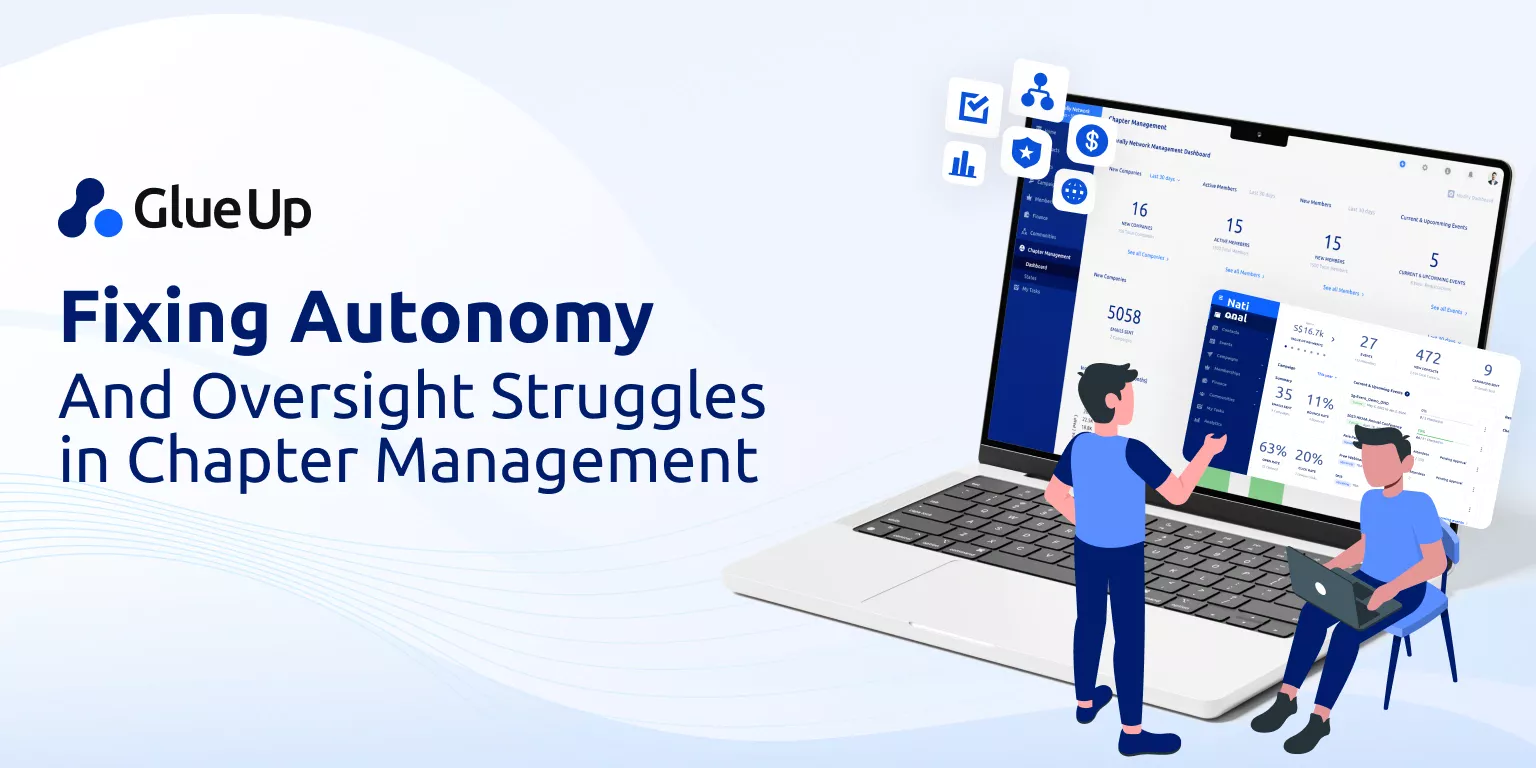
It’s Tuesday morning, and chapter locations are already causing chaos. Your inbox is filling up—twelve unread emails, five marked “urgent.” One chapter lead from Austin flags a membership record that doesn’t match HQ’s. Your CRM shows the member is active. Their local admin says access expired two weeks ago. Meanwhile, finance is chasing down yet another dues report from the Southern region that doesn’t align with what’s in QuickBooks. You open the same spreadsheet you’ve renamed a dozen times—Membership Master Sheet – FINAL – V7 – March.
This isn’t an exception. It’s everyday reality for organizations managing chapter locations without centralized profiles or connected reporting.
Chapter Locations and the Chaos of Fragmentation
It’s a problem that scales with your growth. The more chapters you have: regional, national, international, the more likely your data is split across inboxes, shared drives, PDFs, and outdated processes.
Let’s call it what it is: fragmentation. And fragmentation is the enemy of member trust.
When chapters operate in silos, managing their own events, dues, and communications with no connection to HQ or each other, you lose time. You lose visibility, consistency, and eventually credibility.
Members feel it. They get different messages depending on the chapter. They sign up for an event in New York and get a follow-up from a different CRM than the one used by their home chapter in Boston. Sometimes they’re in two systems, and neither is accurate.
Staff feel it, too. Your finance team gets different reporting templates from each chapter. Regional directors spend hours copy-pasting engagement metrics. Your leadership team’s “big picture” isn’t really a picture at all, it’s patchwork.
All of this is common. But it’s not necessary. Especially not if you're already using Glue Up.
Chapter Locations Need Real-Time, Real-Structure Profiles
The good news? There’s no need to “build” a new system. If you’re already a Glue Up user, the solution is already inside your platform: Chapter Management. Let’s break it down.
At the core is the centralized member profile, a single source of truth. This is not a glorified spreadsheet. It’s a living, breathing profile that reflects a member’s activities across all chapter locations: their event history, dues status, communication preferences, certifications, and more.
The beauty of it? No matter which chapter they interact with, they work from the same record. The chapters don’t have to ask HQ for data. HQ doesn’t have to chase chapters for updates. Everyone is working from the same page, literally.
But unified profiles are just the start. Chapter Management at Glue Up unlocks structural clarity: configurable hierarchies, role-based permissions, data-sharing rules. This means your New England region can have five chapters with their own admins and workflows, while still syncing into a parent structure that keeps everything consistent and compliant.
And it’s flexible. Do you need chapters to manage your own events? Great. Want HQ to oversee all financials? You can do that, too. With Chapter Management, you don’t have to choose between centralization and autonomy. You get both.
Chapter Locations Deserve Reporting That Drives Growth
The silent killer of most chapter-based operations? Reporting chaos. Chapter admins export CSVs from one system. HQ tries to import them into another. Finance reconciles numbers that are days—or weeks—out of date.
The result? Late decisions. Missed targets. Member insights that never surface because the data can’t connect.
Glue Up’s Chapter Management flips that script. Instead of chasing numbers, you generate live dashboards, by chapter, by region, by the entire org. Whether you're looking at renewals, event ROI, or member growth, you’re seeing it in real time, not in revision 8 of someone’s spreadsheet.
Picture this: Your Midwest Director opens her dashboard and sees that two chapters are outperforming event attendance, but one is lagging in membership renewals. She clicks through, finds the drop-off point in the member's journey, and schedules a fix, all before noon. That’s not the future. That’s built in.
Real data. Real-time. Real decisions.
Chapter Locations Require Flexibility
You’ve probably been told that “centralized” means control. But what you really want is clarity without controlling freakery.
Chapters know their locality better than HQ ever will. They know what themes get attendance. What businesses are active. What partnerships work. So, Chapter Management doesn’t strip that power away; it reinforces it.
Admins at the chapter level can manage their events, campaigns, and even memberships, all while staying in compliance with HQ rules. You control what they can do, see, and edit. They work inside that framework, not around it.
Think of it like local lanes on a highway. Everyone’s heading in the same direction, but they have the autonomy to go faster, take the exit, or pull over.
Permissions are granular. Finance access doesn’t mean marketing access. Membership visibility doesn’t mean admin rights. You set the rules once, and they cascade down across chapter locations. No more guesswork. No more shadow systems.
Chapter Locations and Data You Can Trust
If you’re handling member data, names, emails, billing details, activity history and administrator. You’re a steward of trust.
Data fragmentation makes trust fragile. It increases the risk of errors, privacy violations, and conflicting records. And when your members notice those gaps, they don’t see “systems problems.” They see your organization as unreliable.
Glue Up solves this by ensuring that member data is stored, accessed, and updated securely in a cloud system that meets global compliance standards.
Encryption? Yes. Role-based access? Of course. Version control, audit logs, and GDPR-readiness? Absolutely.
And here's the underrated win: data synchronization. When a chapter admin updates a record, say, a new email address or company, the update reflects across the platform, without any “resend spreadsheet” loops.
This is what digital maturity looks like. Not just software, but governance embedded into the experience.
How to Activate Glue Up’s Chapter Management
If you’re already using Glue Up, you’re closer than you think to solving one of the most persistent structural challenges in member-based organizations: fragmented chapter operations.
Chapter Management isn’t a separate platform. It’s a feature embedded in your existing Glue Up system, designed to bring structure, visibility, and confidence to how chapters operate.
And in case you’re wondering whether it’s worth activating, here’s what centralized chapter coordination unlocks across your organization:
1. Hierarchical Chapter Structures That Match Your Real-World Operations
Whether your organization is regional, national, or international, Glue Up’s Chapter Management allows you to replicate your governance structure digitally. You can build layers: national HQ, regions, sub-regions, chapters, subchapters; so, each level sees what it needs and acts within defined parameters.
This mirrors how successful federated associations like IEEE and Rotary International structure their systems, allowing both local relevance and organizational consistency.
2. Unified Member Profiles, No Matter Where They Engage
Activate once, and every chapter taps into a single source of truth for each member. A user’s dues status, event history, communication preferences, and certifications are all tied to one record, updated in real time across every chapter.
This alone helps prevent duplicate records, conflicting updates, or missed renewals, a known issue in federated systems, where overlapping databases can reduce data accuracy by up to 40%.
3. Role-Based Access That Keeps Autonomy with Accountability
With Glue Up, chapter leads can manage their own events, communications, and membership tasks without bypassing HQ governance. Role-based permissions mean you can define exactly who can see, edit, or manage specific functions, ensuring compliance without slowing down local execution.
This helps reduce the administrative bottleneck often cited by regional admins and improves operational speed across locations.
4. Consolidated Dashboards That Update in Real Time
Once activated, your dashboards can show performance by chapter, by region, or across the entire organization. No more reconciling different formats. No more email spreadsheets the day before the board meeting.
You’ll get automated views of engagement, growth, renewals, and event metrics, saving hours of staff time each week and improving decision-making cycles across leadership.
According to TechRepublic, organizations that replace manual reporting with centralized dashboards see a 24–27% increase in decision speed and accuracy.
5. Tools Chapters Need, Without Third-Party Workarounds
Each chapter can run its own programs within the same ecosystem, whether it’s local events, communications, surveys, or membership drives. Everything feeds back into your central platform.
No more disconnected Zoom accounts. No more third-party campaign tools. Just Glue Up, doing what it already does, now across every location.
No data migration. No retraining your team. Just turning on the capability you already own and finally gaining the visibility and structure your chapters have needed for years.
Chapter Locations Are Your Front Line, Treat Them Like It
When chapters feel disconnected, your members do too.
And when members disengage, they don’t always tell you; they just stop showing up. Fewer event signups. Missed dues. Quiet opt-out. The numbers speak before anyone else does.
But that’s avoidable. You already have the tools to create a structure where every chapter operates with confidence, your data stays in sync, and you get the visibility you need, without all the back-and-forth.
If you’re already using Glue Up, Chapter Management is just a step away. It’s not a new platform. It’s a powerful upgrade inside the system you’re already familiar with.
Go to your Add-On Cart to activate Chapter Management. Need help? Your account manager or support team is here for you.
Give your chapters the clarity they need. Give yourself the visibility you’ve earned.



